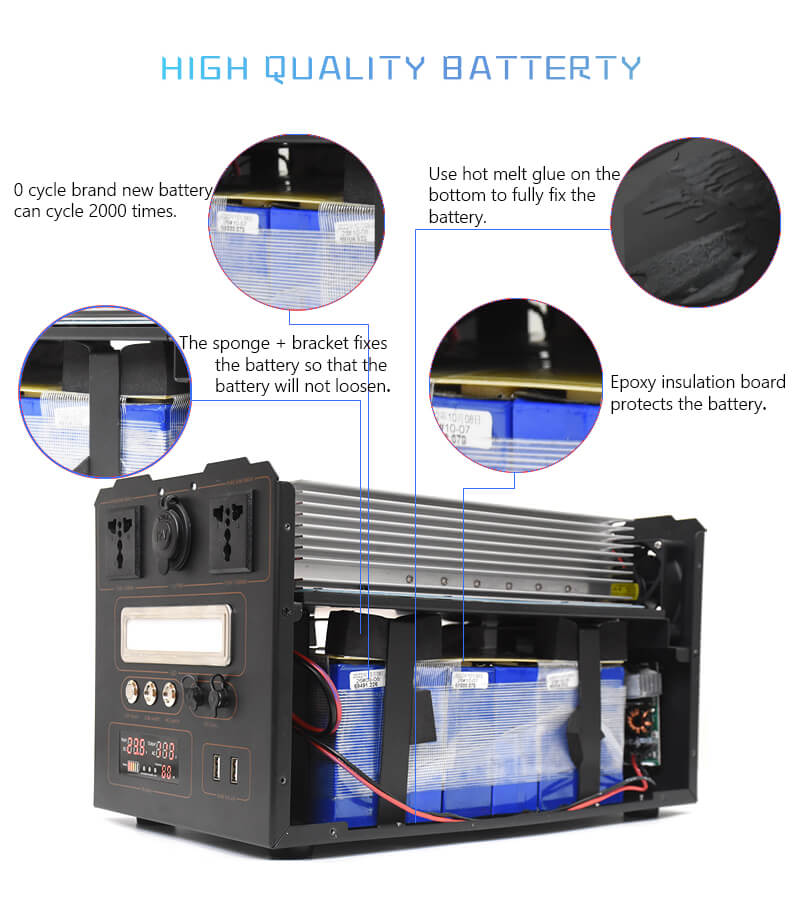3 Main Points About Ordering Portable Power Stations
 Mar 20,2023
Mar 20,2023

 Huaming New Energy
Huaming New Energy
With advances in battery technology, portable power stations have enough capacity and raw power to reliably power electronic devices that require much more power than ordinary power banks can provide. While not as powerful as gas generators, they are quieter, lighter, and don't require fuel to start providing electricity.
So if you're ordering portable power stations, here are 3 main points you should be aware of when shopping for a new power plant.
1. The Capacity of Battery
When looking for a portable power station, battery capacity is the most important specification you should be looking for. The larger the battery capacity, the longer you can run your device per charge. So, in general, buy the battery with the largest capacity possible.
However, given size, weight, and cost, you may wish to take a more calculated approach when considering battery capacity for a portable power station.
Knowing battery capacity can be confusing since different manufacturers use different metrics to measure the battery capacity of their portable power stations. The most common metrics used to measure battery capacity include mAh (milliampere hours), Ah (ampere hours), Wh (watt hours), and kWh (kilowatt hours).
Electronic devices usually indicate their maximum power consumption in watt-hours, which you can find on various types of power supplies. If a power supply is rated in watts, remember that one watt equals one watt-hour.

2. Battery Type
Another important thing you should be looking for in a portable power station is battery technology or the type of battery it utilizes. The type of battery used in a portable power station heavily determines the size, weight, cost, charging speed, and how long your power station can keep producing AC power before cutting off.
Lithium-ion (Li-Ion), lithium-polymer (Li-Po), and lead-acid batteries are the most common batteries used in portable power stations.
Lithium-ion batteries charge three times faster than lead-acid batteries and are the most energy dense out of the three. On the other hand, lithium-polymer batteries are less energy dense than Li-Ion batteries but have fast charging capabilities and are generally safer to use than Li-Ion and lead acid batteries. While lead-acid batteries are the most affordable of the three, but are also bulky, slow-charging, and have the least energy density.
If you're looking for something packable, lighter, and can be used frequently, then a Li-Ion battery is usually worth the investment. But if you want something safer, fast charging, and have the lowest passive discharge rate, then a Li-Po battery power station might be the better option.
Lead-acid batteries aren't usually recommended, but if you really need a cheap set-and-forget backup power station to use during emergencies, then a lead-acid power station should suffice.
3. The Quality of Inverter
Depending on the devices you'll be powering, having the right inverter in your portable power station can keep your delicate equipment safe from damage and keep them working as efficiently as possible, saving battery power.
A power inverter is an electronic component that converts a battery's direct current (DC) to alternating current (AC). Direct current is used to charge battery-operated handheld devices such as cell phones, tablets and Bluetooth headsets, while alternating current is used to power more power-hungry devices such as laptops, computers, TVs and game consoles.
Generally, there are two types of inverters; they are pure sine wave inverters and modified sine wave inverters. A pure sine wave inverter provides a clean sine wave that produces alternating current, while a modified sine wave inverter uses pulse width modulation (PWM), which produces an electrical signal that attempts to mimic a pure sine wave signal.
If you are powering delicate, delicate and highly sensitive equipment, then a pure sine wave inverter should be your only option. However, if you're only going to use your power station to power computers, monitors, consoles, and TVs, then a power station with a modified sine wave inverter should work just fine while saving you quite a bit of money.









 CN
CN
 HOME
HOME What Are the Reasons to Order Solar Power Banks ?
What Are the Reasons to Order Solar Power Banks ?  You May Also Like
You May Also Like







 Tel
Tel
 Email
Email
 Address
Address









